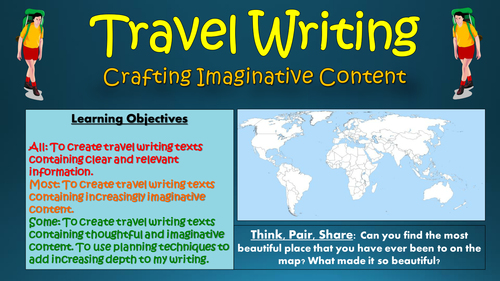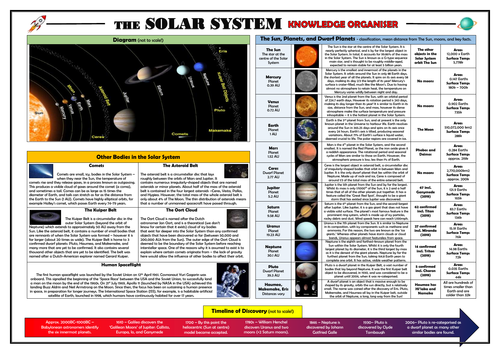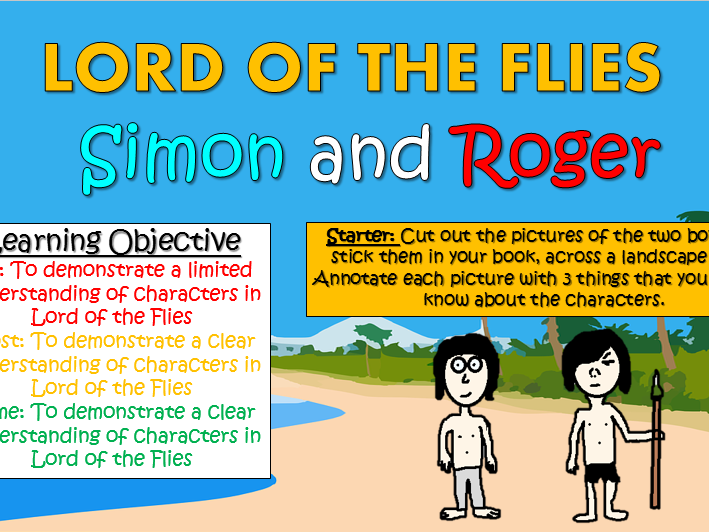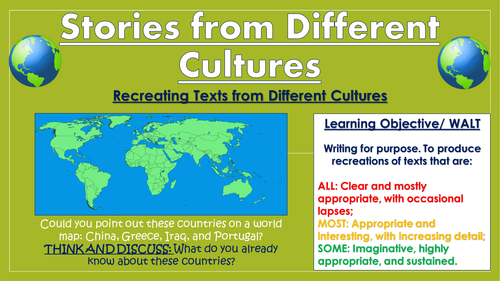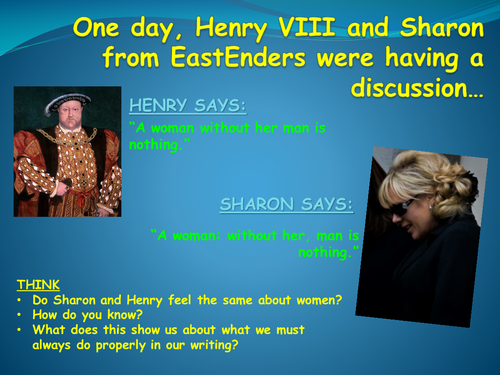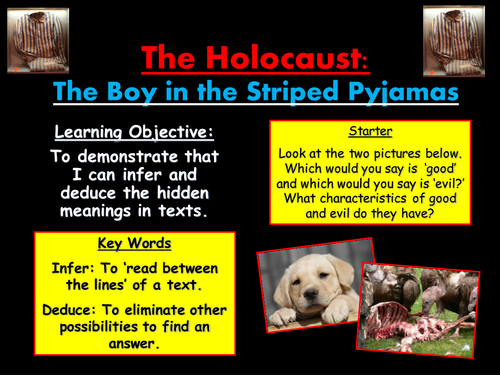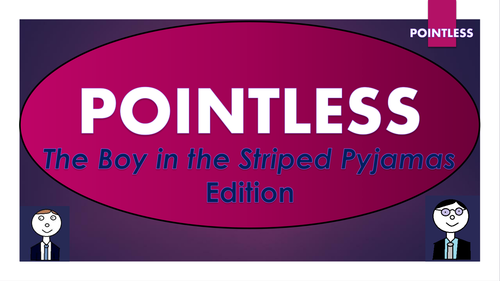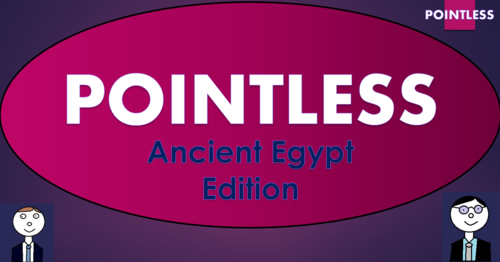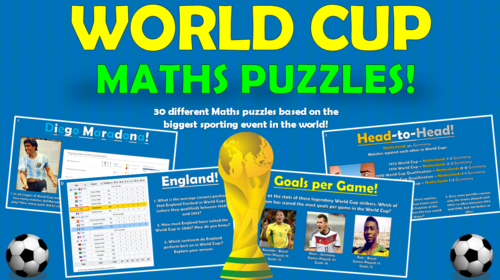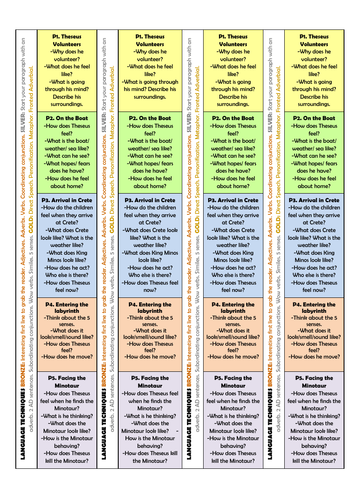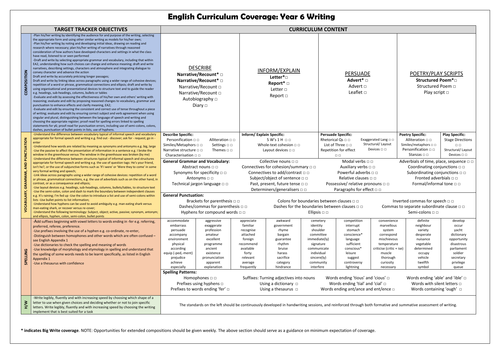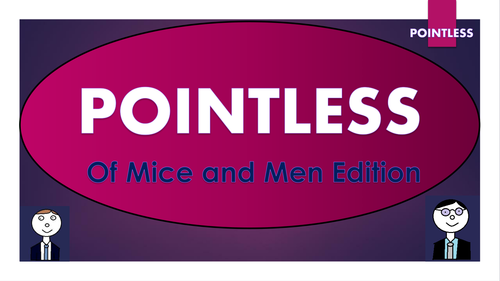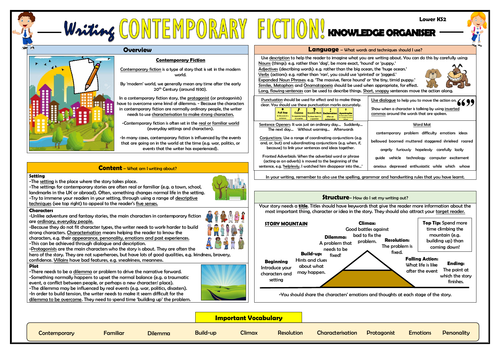
3k+Uploads
1858k+Views
2206k+Downloads
All resources

Determiners Writing Mat!
This colourful writing mat categorises, defines, and exemplifies the different types of determiners.
I found it really useful when teaching determiners to both KS1 and KS2 children.
Hope that you also find useful!
Note: This mat works well with the 'Delightful Determiners' lesson, available at just 2 pounds.

Travel Writing: Crafting Imaginative Content
This thought-provoking and stimulating lesson enables students to create travel writing texts containing thoughtful and imaginative content, utilising planning techniques to add increasing depth to their writing. By the end of the lesson, students are able to understand which features should go into a travel writing piece, and use strategies to enable them to write in appropriate depth for the needs of purpose, audience, and form.
The lesson follows a clear, logical, bite-size learning journey, which guides students towards differentiated learning objectives. Over the course of this journey, they become able to:
- Define what travel writing is, and understand why it is an important and popular genre;
- Think beyond the obvious, noticing and describing subliminal and periphery features, in addition to those which they deem as most important and pressing;
- Consider how stimulus can be described using each of the different senses;
- Use a success criteria to analyse a model travel writing attempt, and to plan their own;
- Self/Peer assess travel writing attempts.
This resource pack includes:
- A visually engaging whole-lesson PowerPoint presentation;
- A clear and logical template to record descriptions during the sensory task;
-A well-structured success criteria/ planning template to aid students' creative attempts;
- A detailed lesson plan, complete with what the teacher and students should aim to achieve at each stage of the lesson.
All images are licensed for commercial use, and are cited on the final slide of the PowerPoint/ the bottom of worksheets.

The Solar System Knowledge Organiser/ Revision Mat!
This detailed and visually-appealing resource offers a complete reference point for students learning or revising knowledge relating to The Solar System. It contains comprehensive sections on:
- The Sun, Planets, and Dwarf Planets - including classification, mean distance from the sun, size, and key composition information;
- Other Bodies in the Solar System - including comets, the asteroid belt, the Kuiper belt, and the Oort cloud;
- Human Spaceflight;
- Timeline of Discovery;
Key words and ideas are categorised logically for easy reference. The resource is designed to be printed onto A3, and is provided as both a PDF and a Word version (so that you can edit if you want to). All images used are licensed for commercial use and are cited on a separate document (included).

Lord of the Flies: Simon and Roger
This interesting and highly-stimulating lesson enables students to gain a clear understanding of how the characters of Simon and Roger are introduced and developed in William Golding’s Lord of the Flies. Students learn to compare and contrast the two characters, with particular reference to their respective propensities for kindness and savagery.
The lesson follows a clear, logical, bite-size learning journey, which guides students towards differentiated learning objectives. Over the course of this journey, they become able to:
- Use illustrations to explain what they already know about each of the characters;
- Understand how each of the characters are introduced, and demonstrate an awareness of the role that they play on the island;
- Read and understand Chapters Eight, Nine, and Ten of the play, with a particular focus upon how the characters of Simon and Roger can be compared, and how they develop over time;
- Analyse key quotations about/by each of the characters,interpreting what this shows the readers about their characters;
- Complete a comparison between the two characters, in response to an essay-style question;
-Peer assess each other's learning attempts.
This resource pack includes:
- A visually engaging whole-lesson PowerPoint presentation;
- Detailed worksheets, with answer sheets where necessary;
- Links to the extracts of the text needed for the lesson (Chapters Eight, Nine and Ten in this case);
- Original images for students to complete their annotations;
- A logically scaffolded essay template;
- A detailed lesson plan, complete with what the teacher and students should aim to achieve at each stage of the lesson.
All images are licensed for commercial use, and are cited on the final slide of the PowerPoint.

The Holocaust: Anne Frank's Diary
This lesson aims to help students to build their skill at analysing the language choices in texts, whilst also providing students with valuable SMSC messages about the horror of the Holocaust. Students also hone their skills of writing to analyse, in response to extracts from 'Anne Frank's Diary.'
Informative and engaging, this lesson follows a clear and logical learning journey. Students learn to:
- Define key terms related to the historical context of The Holocaust;
- Remember and understand key information about Anne Frank's experiences, that they learn from an engaging PowerPoint presentation;
- Read extracts from Anne Frank's diary;
- Answer a range of questions to demonstrate their understanding of Anne's diary;
- Analyse the language features used by Anne Frank to create dramatic images in the mind of the reader;
- Peer-assess each others' learning attempts.
Included in this resource pack: A comprehensive, whole-lesson, visually engaging PowerPoint presentation, which guides the teacher and learners through the lesson, a writing to analyse help-sheet, an engaging and helpful worksheet, extracts from 'The Boy in the Striped Pyjamas' and teacher guidance notes.
All images are cited at the end of the PowerPoint presentation, and are licensed for commercial use.

Stories from Different Cultures: Recreations (Double-Lesson!)
These interesting and stimulating resources enable students to read and understand a number of texts from different cultures. Students learn about different countries and their social and historical traditions. Students also learn to recreate texts, honing their knowledge of text content, language, and structure choices, whilst simultaneously building their imaginative writing skills. There are easily enough resources here for 2 lessons, at the very least.
The visually engaging, comprehensive PowerPoint presentation guides students through the following learning journey:
- Learning about the cultures of different countries where the short stories originated;
- Reading and understanding the short stories;
- Collaborating in teams in order to analyse the stories in terms of content, language, and structure;
- Understanding the key term 'recreations' and evaluating two recreations of a famous fable;
- Planning and writing their own recreation of one of the texts from different cultures;
- Peer-assessing the recreation attempts of their partner.
Provided in this resource pack is everything that you need to simply print and teach, including:
- Comprehensive PowerPoint presentation;
- Countries fact-sheets
- 4x short stories (The Island of the Sun - China, Narcissus and Echo - Greece, The Little Beggar - Iraq, and The Princess of Riddles - Portugal.)
- Mind-map activity template;
- Recreations planning template;
- Learning objectives to stick in.
All images are licensed for commercial use and are cited on the final slide.

Story Genres - Double Lesson!
This stimulating and informative double lesson aims to improve students’ ability to understand the features of various story genres, and analyse the conventional language features within them. In particular students focus upon the vocabulary, sentence, and descriptive device choices made by writers across each of the genres, and begin to comprehend the effect of these techniques upon the reader.
Students follow a clear and logical learning journey, in which they:
-Define the different story genres and understand their key content features;
-Understand the key features of different genres through interesting movie clips ;
-Work collaboratively using the jigsaw method to ascertain the language features (vocabulary, sentences, descriptive devices) of different genres;
-Engage with a number of interesting story extracts (Louis Sachar - Holes, JK Rowling - Harry Potter and the Chamber of Secrets, Darren Shan - The Vampire's Assistant, Jeff Kinney - Diary of a Wimpy Kid.)
-Write an analytical piece on some of the language features used by the writer of their chosen genre;
-Peer/self-assess their analytical attempts.
There are enough resources here really for two lessons, including:
-Visually engaging whole-lesson PowerPoint;
-Story extracts x 4 (Harry Potter, Holes, etc.)
-Learning Objective cut out;
-Analytical Paragraphs Template;
-Jigsaw method worksheet
-Step-by-step lesson plan.
All images are licensed for commercial use, and are cited on the final page of the slide.

Capturing the Readers' Attention!
This highly engaging and informative lesson helps students to use appropriate, sophisticated, and original techniques in creating writing that can hold their readers' attention.
Students learn:
- How to use their five senses in writing;
- How to relate the senses to the descriptive devices;
- How to create a 'hook' in their writing;
- How to create mystery in their writing;
- How to analyse and evaluate existing examples of descriptive writing;
Included are all worksheets, and detailed and visual PowerPoint presentation, which explains each concept clearly, cards for the interactive 'senses' game, and a lesson plan for teacher guidance.
Alternatively, you can buy the Descriptive Writing Big Bundle (All descriptive devices lessons, structuring and organising writing lesson, capturing the readers attention lesson, and the literacy writing mat) for £6
All images are licensed for commercial use, and authors are cited on the final slide.

VCOP - Punctuation
Perfect for English lessons, or as part of a literacy across the curriculum scheme, the VCOP lessons aim to build students' fundamental writing skills.
Engaging, differentiated, and easily adaptable, this lesson aims to improve students' skills at using varied and appropriate punctuation, following a logical learning journey to ensure that students learn in bite-size steps:
- Defining punctuation marks;
- Identifying varied vocabulary in humorous writing examples;
- Analysing varied vocabulary in an interesting descriptive passage;
- Creating their descriptive piece, using varied vocabulary;
- Peer or self evaluating their varied vocabulary attempts.
Resources, worksheets, and a lesson plan are provided.
This resource can either be bought alone, or as part of a VCOP bundle (see resource VCOP - All lessons & scheme - vocabulary, connectives, openers, punctuation) for just £1 more.

The Holocaust: The Boy in the Striped Pyjamas
This lesson aims to help students to build their skill at inferring and deducing the hidden meanings in texts, whilst also providing students with valuable SMSC messages about the horror of the Holocaust. Students also hone their skills of writing to argue, utilising information that they gain from reading extracts of John Boyne's 'The Boy in the Striped Pyjamas.'
Informative and engaging, this lesson follows a clear and logical learning journey. Students learn to:
- Define key terms related to reading between the lines of a text;
- Consider the concepts of 'good' and 'evil' using the poem 'Vultures.' Use this knowledge to consider the actions of those involved in the Holocaust;
- Read extracts from The Boy in the Striped Pyjamas;
- Answer a range of questions designed to demonstrate students' ability to infer and deduce the hidden meanings in texts;
- Write an argumentative letter from Bruno's Grandma to his father, using a writing to argue help-sheet;
- Peer-assess each others' learning attempts.
Included in this resource pack: A comprehensive, whole-lesson, visually engaging PowerPoint presentation, which guides the teacher and learners through the lesson, a writing to argue help-sheet, a copy of the poem 'Vultures,' extracts from 'The Boy in the Striped Pyjamas' and teacher guidance notes.
All images are cited at the end of the PowerPoint presentation, and are licensed for commercial use.

The Boy in the Striped Pyjamas - Pointless Game!
Based on the popular game show 'Pointless', this resource is perfect for use as a whole lesson resource, enrichment option, or revision tool. Editable, so that you can change to any other topic or change questions. (I've also added a blank template so that you can make your own games from scratch). Containing almost 30 slides of sound clips, engaging visuals, and suitably challenging questions, this resource is effective at both promoting engagement and enhancing learning. There are several full rounds of questions to build or revisit knowledge of characters, plot, and themes in 'The Boy in the Striped Pyjamas.'
Round 1. The characters in The Boy in the Striped Pyjamas
Round 2. Quotations from the text
Round 3. Settings, themes, and objects
Round 4. Similarities between Bruno and Shmuel
The nature of this game ensures that the resource can challenge students of all levels.
A blank template has also been added, so that you can create your own games!

Song of the Old Mother Comprehension Activities Booklet!
This 16-page resource booklet contains a wide range of challenging and engaging comprehension activities for use throughout the reading of W.B. Yeats’ poem 'Song of the Old Mother.’ They are perfect for aiding the progress of students learning poetry either in KS3 and KS4 in preparation for poetry/unseen poetry at GCSE, as the tasks draw on English Literature assessment objectives - suitable for all examining bodies - it is clearly highlighted within each task regarding which assessment strands the task is designed to demonstrate.
The booklet is provided in both Word (to allow for easy editing) and PDF (to ensure for consistency of formatting between computers).
Activities within the booklet include (amongst many others):
‘Analysing Context’ - helping students to ‘Show understanding of the relationships between texts and the contexts in which they were written.’
‘Analysing Subject Matter, Language and Structure’ - to help students to ‘Analyse the language, form and structure used by a writer to create meanings and effects, using relevant subject terminology where appropriate.’
‘Diary Entry’ - to help students to ‘Use a range of vocabulary and sentence structures for clarity, purpose and effect, with accurate spelling and punctuation. Make an informed personal response, recognising that other responses to a text are possible and evaluating these.’
‘The Speaker’ - to help students to ‘Read, understand and respond to texts. Students should be able to: maintain a critical style and develop an informed personal response use textual references, including quotations, to support and illustrate interpretations.’

Ancient Egypt Pointless Game!
Based on the popular game show ‘Pointless,’ this resource is perfect for use as a whole lesson resource, enrichment option, or revision tool. Editable, so that you can change to any other topic or change questions. (I’ve also added a blank template so that you can make your own games from scratch). Containing 24 slides of sound clips, engaging visuals, and suitably challenging questions, this resource is effective at both promoting engagement and enhancing learning. There are several full rounds of questions to build or revisit knowledge of Ancient Egypt.
Round 1. The pharaohs of Ancient Egypt
Round 2. Places in Ancient Egypt
Round 3. Hieroglyphics Round
Round 4. Objects and Ideas in Ancient Egypt
Round 5. Ancient Egyptian Gods
The nature of this game ensures that the resource can challenge students of all levels.
A blank template has also been added, so that you can create your own games!

Ancient Greece Pointless Game!
Based on the popular game show ‘Pointless,’ this resource is perfect for use as a whole lesson resource, enrichment option, or revision tool. Editable, so that you can change to any other topic or change questions. (I’ve also added a blank template so that you can make your own games from scratch). Containing 24 slides of sound clips, engaging visuals, and suitably challenging questions, this resource is effective at both promoting engagement and enhancing learning. There are several full rounds of questions to build or revisit knowledge of Ancient Greece.
Round 1. Ancient Greek Gods
Round 2. Places in Ancient Greece
Round 3. Key Dates
Round 4. Objects and Ideas in Ancient Greece
Round 5. Famous Ancient Greeks
The nature of this game ensures that the resource can challenge students of all levels.
A blank template has also been added, so that you can create your own games!

World Cup Maths Puzzles!
These short and snappy puzzles are perfect for engaging all of the World Cup lovers in your class with a wide range of maths problems! Using real-life statistics from FIFA World Cups past and present, students approach a number of varied maths topics, whilst also gaining valuable information about their favourite teams and players. I have used these resources with a number of KS2 and KS3 classes, and have found that they work great for morning mental maths challenges or lesson starters/ fillers.
Some of the maths topics covered include: statistics, percentages, charts and graphs, data handling, averages, ratios, addition, subtraction, multiplication, and division, estimation and problem solving, critical thinking, and fractions. Some of the specific tasks involved include: working out the goals to games ratio of some of the best strikers, finding out which teams have the best goal difference, creating data to present performance, and comparing player statistics over different tournaments.
There are 30 tasks in total, in which each the major World Cup nations are focused upon in at least one activity each. The tasks are also separated by difficulty into ‘Beginner’,‘Intermediate’, and ‘Difficult’ tasks (refer to the B, I, or D symbols in the top left of each activity).
All images within this resource are licensed for commercial use, and images are cited on the final slide.

Theseus and the Minotaur Creative Writing Structure Strips!
These creative writing structure strips are designed to help children with formulating creative writing pieces based on Theseus and the Minotaur. They are tried and tested in the classroom - they are loved by teachers and students, and have helped to enable some incredible compositions!
These structure strips were initially designed for KS2 children, however (perhaps with a tweak here and there) they could be used for lower KS3 or upper KS1.
Provided in both PDF (to prevent formatting issues between computers) and Word (to allow for easy editing). Each A4 page contains 4 structure strips. Hope that they prove useful for you too - Enjoy!

Nineteen Eighty-Four (1984) Pointless Game!
Based on the popular game show ‘Pointless’, this resource is perfect for use as a whole lesson resource, enrichment option, or revision tool. Editable, so that you can change to any other topic or change questions. (I’ve also added a blank template so that you can make your own games from scratch). Containing almost 30 slides of sound clips and suitably challenging questions, this resource is effective at both promoting engagement and enhancing learning. There are several full rounds of questions to build or revisit knowledge of characters, plot, and themes in ‘Nineteen Eighty-Four (1984).’
Round 1. The characters in Nineteen Eighty-Four
Round 2. Quotations from the text
Round 3. Settings and Objects
Round 4. Themes in Nineteen Eighty-Four
The nature of this game ensures that the resource can challenge students of all levels.
A blank template has also been added, so that you can create your own games!

Year 6 Writing Curriculum Coverage Checklist!
This checklist provides an academic overview of the writing curriculum content to be covered in Year 6. I offered this to teachers, who marked it off as they covered individual elements of the curriculum (their aim was to ‘tick’ each element twice over an academic year). They have found it extremely useful, as it offers a useful breakdown of the curriculum statements into individual components, which are not always self-explanatory. It is broken down into Composition, Vocabulary, Grammar and Punctuation, Spelling, and Handwriting sections.
Please note that the spellings listed are indicative of the patterns to be learnt - it is not the exhaustive list. Furthermore, the composition section details our interpretation of what needs to be covered over a year, some schools vary from this. For this reason, the document is provided in Word, for easy editing. It is also provided as a PDF, to prevent formatting issues between computers.
Hope that this proves helpful to you too!

Pointless - Of Mice and Men Edition
Based on the popular game show 'Pointless', this resource is perfect for use as a starter activity, plenary, or revision tool. Editable, so that you can change to any other topic or change questions. Containing almost 30 slides of sound clips, engaging visuals, and suitably challenging questions, this resource is effective at both promoting engagement and enhancing learning. There are several full rounds of questions to build learning of Of Mice and Men:
1. The characters in Of Mice and Men
2. Quotations from the text
3. Settings, themes, and objects
4. Animals in Of Mice and Men
The nature of the game ensures that this resource can challenge students of all levels.

Writing Contemporary Fiction - Lower KS2 Knowledge Organiser!
This clear, detailed and visually-appealing resource offers a complete reference point for lower KS2 children when writing contemporary fiction. The organiser is also perfect for teachers, parents and English subject leaders - aiding their planning and supporting of children’s knowledge development for this writing text type.
The organiser has a particular focus on the content, language and structural features required to write effective adventure stories at lower KS2. It contains distinct sections covering:
-Overview: Contemporary Fiction;
-Content: Settings, Characters, and Plot;
-Language: Descriptive Devices, Dialogue, Conjunctions, Punctuation Checklist, Sentence Openers and Word Mat;
-Structure - Titles, Structure Mountains and other tips;
-Key Vocabulary
The content is fully aligned with the age-related expectations for lower KS2 children in writing. The resource is designed to be printed onto A3, and is provided as both a PDF and a Word version (so that you can edit if you want to). All images used are licensed for commercial use and are cited on a separate document (included).


